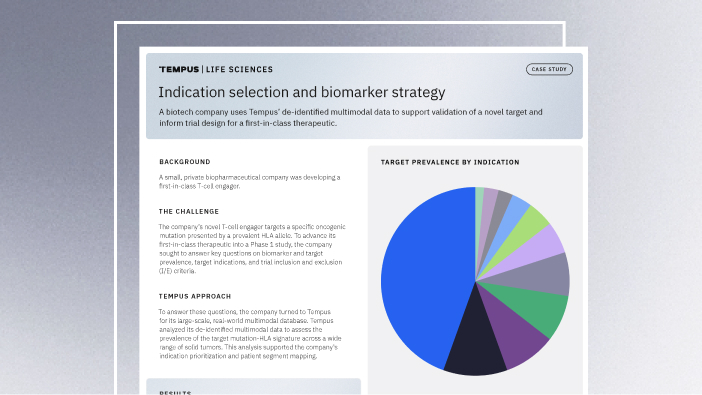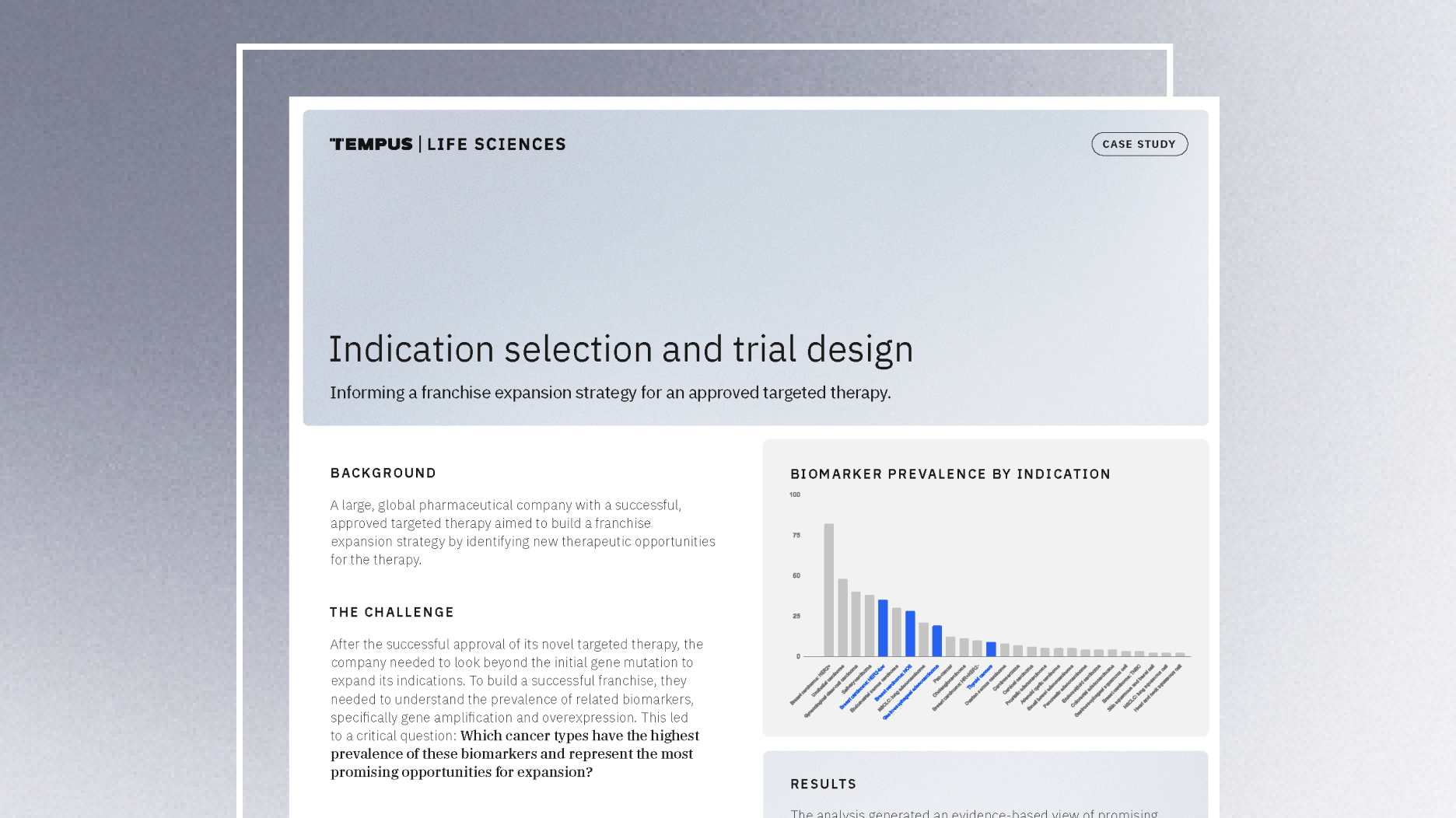-
PROVIDERS
New MRD Medicare Coverage for Select Indications*
*When coverage criteria are met. Additional criteria and exceptions for coverage may apply.
-
LIFE SCIENCES
REGISTER NOW
UPCOMING WEBINAR
Driving enterprise value with RWD -
PATIENTS
It's About Time
View the Tempus vision.
- RESOURCES
-
ABOUT US
View Job Postings
We’re looking for people who can change the world.
- INVESTORS
05/28/2025
Q&A: Harnessing generative AI to refine clinical research & drug development
Maria Berezine, VP of Real World Data at Tempus, recently led a webinar with leaders across healthcare and life sciences to discuss the impact generative AI tools have on maximizing the value of multimodal data.
Authors
Maria Berezina, PhD
VP, Real World Data, Tempus

VP, Real World Data, Tempus

Speakers
Jess Huang
VP & GM of Lens, Tempus

Kathleen Burke, PhD
Senior Director, Computational Biology & Pharma R&D, Tempus

Edwin Posadas, MD
Director, Cancer Therapeutics Program; Medical Director, Center for Uro-Oncology Research Excellence, Cedars-Sinai Cancer

Joshua Watson, PhD
Postdoctoral Scientist, Cedars-Sinai Cancer

VP & GM of Lens, Tempus

Kathleen Burke, PhD
Senior Director, Computational Biology & Pharma R&D, Tempus

Edwin Posadas, MD
Director, Cancer Therapeutics Program; Medical Director, Center for Uro-Oncology Research Excellence, Cedars-Sinai Cancer

Joshua Watson, PhD
Postdoctoral Scientist, Cedars-Sinai Cancer

Lens is a purpose-built platform designed to facilitate the rapid generation of insights from Tempus’ multimodal data library of over 8M research records. The platform revolutionizes the way researchers leverage real-world data (RWD) with the integration of Tempus One, a powerful generative AI assistant that provides access to patient insights. Lens users can now construct highly specific patient cohorts using natural language in seconds, even with massive datasets. To facilitate faster analysis, Lens offers Workspaces, a dedicated cloud environment equipped with a suite of analytic tools and support for querying in your preferred coding language.
The engaging session featured Jess Huang, Vice President and General Manager of Lens at Tempus, who spoke to the platform’s ability to empower researchers to uncover critical insights that help accelerate innovation and improve patient outcomes with ease.
Dr. Edwin Posadas, MD, Director of the Cancer Therapeutics Program & Medical Director of the Center for Uro-Oncology Research Excellence at Cedars-Sinai Cancer, Joshua Watson, PhD, Postdoctoral Scientist at Cedars-Sinai Cancer, and Kathleen Burke, PhD, Senior Director of Computational Biology & Pharma R&D at Tempus, also spoke to strategies for integrating generative AI into workflows and shared real-world examples of how these advanced technologies are advancing their research.
|
“Tempus’s AI tools within Lens have significantly accelerated my research, enabling me to identify distinct patient subsets much faster than traditional methods.” – Edwin Posadas, MD, Director, Cancer Therapeutics Program; Medical Director, Center for Uro-Oncology Research Excellence, Cedars-Sinai Cancer |
Applying Lens to enhance research efficiency & deliver actionable knowledge
Dr. Posadas and Dr. Burke, could you please describe the context of how you leverage RWD and provide an overview of the new capabilities and advancements that generative AI has unlocked for your work? |
Edwin Posadas, MD: At Cedars-Sinai, my clinical and lab work concentrates on advanced prostate cancer, a disease that has become increasingly complex. This complexity creates challenges in data annotation, particularly in understanding treatment backgrounds. Generative AI has been instrumental in addressing specific questions about treatment variations and prostate cancer biology. Public databases often lack annotation and group castration-resistant prostate cancer as one entity when, in reality, it represents multiple different entities. As a clinical scientist, distinguishing these patient groups is crucial. Tempus’s AI tools within Lens have significantly accelerated my research, enabling me to identify distinct patient subsets much faster than traditional methods.Kathleen Burke, PhD: My work aims to help answer critical questions across various indications for our large pharma alliances, providing a broader perspective on generative AI’s application. Unlike Dr. Posadas’ focused cohort approach, we explore how generative AI can leverage larger real-world datasets. Traditionally, RWD analysis was limited by structured data and the cost of manual curation. Earlier NLP tools extracted single features. Generative AI now allows us to extract diverse features from unstructured text, maximizing information analysis. Through client collaborations, we’ve identified three key applications: identifying patients with rare cancers or complex clinical features, enriching data with previously uncurated features directly from unstructured data, and enabling detailed analysis of individual patients or small cohorts. |
Dr. Posadas and Dr. Watson, what specific advancements in your clinical research have been directly enabled by generative AI? |
Joshua Watson, PhD: We’ve been developing patient clinical experience timelines, including adverse events, surgeries, and treatments, using Lens. By pairing gene expression with these timelines, which often include multiple samples per patient, we can correlate treatments with gene expression changes. While Lens’ structured data provides valuable information, it doesn’t fully capture the complexity of a patient’s disease journey. That’s where Patient Explorer, a feature within Lens that allows researchers and scientists to define and refine patient cohorts using a broad set of filters, comes in. It builds a data matrix for each patient based on physician notes, which I, as a PhD, don’t typically review. For instance, I can input patient characteristics and query metastatic locations. Patient Explorer then provides an answer, citing relevant physician notes that would take me hours to sift through normally. I can now answer a question about 200 patients in five minutes. This allows me to identify patterns that I can then discuss with clinicians like Dr. Posadas, who can translate those patterns into clinically relevant insights.Edwin Posadas, MD: To contextualize what Josh said, with osteotropic prostate cancer, we see variations like visceral metastases that correlate with poorer outcomes. So, understanding the sequence of metastatic sites and related events offers insights into biological changes. This allows us to investigate if these signals were present at diagnosis or developed through treatments. This requires temporal analysis across the disease’s natural history and contextualizing it with genomic information that is acquired throughout the disease’s timeline. As Josh mentioned, this is a laborious manual process. However, Tempus’ generative AI tools enable us to rapidly explore these variations. We can iteratively examine how specific events correlate with clinical outcomes, such as treatment benefits or metastasis patterns. This also allows us to analyze time-on-treatment variations. For example, we can compare treatment responses in patients with specific metastatic and gene expression patterns, which is incredibly unique and gives us a leg up by significantly accelerating our research. |
|
“Patient Explorer allowed me to analyze physician notes, identifying previously uncaptured samples with primary tumor sequencing data that also mentioned my metastatic locations of interest. Using this approach, I was able to increase the cohort size of valuable patients for this specific phenotype by 50%.” – Joshua Watson, PhD, Postdoctoral Scientist, Cedars-Sinai Cancer |
Lens in action: Case studies
Could you share a de-identified case study that illustrates how AI-enabled capabilities have significantly advanced your research? |
Joshua Watson, PhD: My research focuses on specific metastatic locations in prostate cancer, and often, gene expression data for this cancer type is limited to the primary tumor, lacking metastatic and longitudinal information. Patient Explorer allowed me to analyze physician notes, identifying previously uncaptured samples with primary tumor sequencing data that also mentioned my metastatic locations of interest. Using this approach, I was able to increase the cohort size of valuable patients for this specific phenotype by 50%.Edwin Posadas, MD: At Cedars-Sinai, we have a National Cancer Institute-funded program project grant that examines liver metastasis across various cancers and my interest is examining hepatic metastases in prostate cancer. Applying Josh’s approach, we can analyze gene expression patterns associated with metastasis of colon, pancreatic, and breast cancers. This allows us to compare and contrast these patterns and investigate treatment histories that may contribute to metastasis. For example, we can differentiate treatment-emergent liver metastases in prostate and breast cancer from the higher incidence in pancreatic and colon cancer, and by being able to run these analyses and examine treatment histories, we’re able to advance our research.Kathleen Burke, PhD: To continue the theme of the ability of the LLM’s tools to explore unstructured documents and identify patients with specific clinical features or rare conditions within the millions of uncurated patients that we have in our database, at Tempus, we used Lens’ generative AI to identify patients with hemophagocytic lymphohistiocytosis (HLH), a rare secondary condition in cancer patients that can occur after the start of treatment. This allowed us to build a cohort, perform enhanced curation, and extract relevant information to address an analytical question. Because HLH is not well understood, accessing this patient data was critical. The process enabled rapid patient identification and provided crucial analytical insights for a high-priority client inquiry. |
Dr. Posadas and Dr. Watson, what specific advancements in your clinical research have been directly enabled by generative AI? |
Joshua Watson, PhD: We’ve been developing patient clinical experience timelines, including adverse events, surgeries, and treatments, using Lens. By pairing gene expression with these timelines, which often include multiple samples per patient, we can correlate treatments with gene expression changes. While Lens’ structured data provides valuable information, it doesn’t fully capture the complexity of a patient’s disease journey. That’s where Patient Explorer, a feature within Lens that allows researchers and scientists to define and refine patient cohorts using a broad set of filters, comes in. It builds a data matrix for each patient based on physician notes, which I, as a PhD, don’t typically review. For instance, I can input patient characteristics and query metastatic locations. Patient Explorer then provides an answer, citing relevant physician notes that would take me hours to sift through normally. I can now answer a question about 200 patients in five minutes. This allows me to identify patterns that I can then discuss with clinicians like Dr. Posadas, who can translate those patterns into clinically relevant insights.Edwin Posadas, MD: To contextualize what Josh said, with osteotropic prostate cancer, we see variations like visceral metastases that correlate with poorer outcomes. So, understanding the sequence of metastatic sites and related events offers insights into biological changes. This allows us to investigate if these signals were present at diagnosis or developed through treatments. This requires temporal analysis across the disease’s natural history and contextualizing it with genomic information that is acquired throughout the disease’s timeline. As Josh mentioned, this is a laborious manual process. However, Tempus’ generative AI tools enable us to rapidly explore these variations. We can iteratively examine how specific events correlate with clinical outcomes, such as treatment benefits or metastasis patterns. This also allows us to analyze time-on-treatment variations. For example, we can compare treatment responses in patients with specific metastatic and gene expression patterns, which is incredibly unique and gives us a leg up by significantly accelerating our research. |
Generative AI’s practical and future impact
What key considerations should researchers keep in mind when integrating generative AI into their workflows? |
Edwin Posadas, MD: When using generative AI, query precision is crucial. Broad queries yield noisy data, while overly narrow queries can miss relevant information. It requires practice to refine queries effectively. I’ve found that collaboration with Tempus experts is invaluable, especially when learning to use Patient Explorer. Their guidance in shaping data queries has been essential for obtaining accurate results. This collaboration also facilitates further data analysis and question formulation.Joshua Watson, PhD: My key advice for scientists using generative AI is to always double-check your work. While generative AI is a powerful tool, it’s not perfect. It’s also important to have a well-defined research goal before you start applying AI to your work. Generative AI tools can answer questions quickly, but they might not understand the ‘why’ behind the questions. Use your knowledge to guide your queries and evaluate the AI’s responses. Finally, while generative AI can write code, it’s not a substitute for coding skills. It’s important to always understand the generated code before using it.Kathleen Burke, PhD: Building on the importance of crafting effective queries, the one thing that I would add is starting with a use case that you are comfortable with. You might want to start with a question you know won’t have an adequate answer to what you are trying to understand, so while you’re learning how to build queries and leverage generative AI tools, I recommend starting in an area of your expertise. This allows you to compare the AI’s results against your existing knowledge to understand how to build optimal queries. Once you’re comfortable with query construction, you can then tackle your specific research questions of interest. It’s also crucial to iterate on your queries and validate the output by reviewing the source text and, where possible, comparing the results with overlapping datasets to ensure accuracy. |
How do you anticipate generative AI influencing the clinical trials and drug discovery landscape in the coming years? |
Edwin Posadas, MD: Treatment resistance in advanced cancers is a growing challenge, so understanding how a patient reacts after treatment at a molecular level to gauge whether or not they may be a candidate for additional therapies is crucial. However, that level of annotation is certainly lacking, especially in prostate cancer. So understanding if a specific molecular targeted approach is appropriate for a subset of patients can be life or death for a clinical trial. Querying a database like Tempus’ can provide better insights into patient populations after a certain series of treatments compared to broader public datasets like The Cancer Genome Atlas Program, which is a significant advantage, especially in early-phase trials where go/no-go decisions regarding patient selection for molecular interventions are made.Kathleen Burke, PhD: From a drug development and RWD perspective, this is a very exciting area for Tempus, impacting data collection, annotation, and interpretation. For our clients’ pipelines, connecting early-stage and late-stage data to inform new targets or biomarkers can be challenging due to rapid development and ever-increasing data. By overcoming curation limitations, these AI tools will improve access to emerging data on new treatments and biomarkers and enable advancements in how we categorize and match patients with optimal targets. |
Take full advantage of Lens
Jess, can users of Lens validate results generated by generative AI, and what is the accuracy of these insights? |
Jess Huang: Yes, validation is possible, especially given our extensive curated data, which serves as a strong ground truth. It requires setting up appropriate experiments and data frameworks for evaluation. Generative AI in Lens performs well with specific queries, and for broader questions, accuracy can vary depending on phrasing. We are currently executing internal benchmarking across different scenarios to better characterize its performance and provide users with guidance. |
Can Tempus One be applied to a broad, unstructured dataset, allowing the AI to filter and identify relevant cohorts, rather than building cohorts in Lens or Explore first? |
Jess Huang: Yes, currently we can apply Tempus One at the thousands-patient level, and we’re increasing that capacity rapidly. We are not yet at the point of applying it to the entire Tempus dataset, but that’s the direction we’re aiming for: using AI more broadly to unlock insights from the entire database, not just delivered datasets. As we scale this capability, you’ll see more use cases for querying the broader database. |
Can you clarify if the ‘Delivered Data’ is a collection of de-identified medical notes? |
Jess Huang: When we deliver a dataset back into Lens for analysis, it’s a combination of structured clinical and molecular data, including raw molecular files and other underlying data, and the unstructured, de-identified clinical notes. |
| In this evolving landscape of data-driven research, Tempus Lens empowers researchers to efficiently analyze complex data, identify key patterns, and derive actionable insights. This enhanced capacity for data analysis, facilitated by generative AI, is streamlining research workflows, enabling deeper understanding of disease, and ultimately driving the development of more effective and personalized therapies for patients. To learn more about Tempus Lens, click here or contact us.
*Note: content edited for clarity. Please note that the content in this document has been revised for clarity and conciseness. Some language and formatting may have been adjusted to enhance readability while preserving the original meaning and intent of the discussion. |
-
11/11/2025
A new era of biopharma R&D: The TechBio revolution—realities and the next frontier
Join Tempus and Recursion leaders to explore their strategic TechBio partnership. Learn how they use AI and supercomputing with petabytes of data to accelerate drug discovery and development. See the impact on biopharma R&D's future.
Watch replay -
11/14/2025
Validating a novel target and informing trial design for a first-in-class therapeutic
Discover how a biopharma company used Tempus’ de-identified multimodal data to support validation of a novel target and inform trial design for a first-in-class therapeutic.
Read more -
11/14/2025
Guiding indication expansion with multimodal real-world data
Discover how a biopharma company used Tempus’ multimodal real-world data to guide its indication expansion strategy. See how our analysis of biomarker prevalence helped them identify new opportunities, prioritize R&D, and inform future trial design.
Read more


